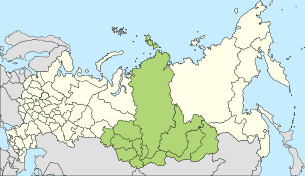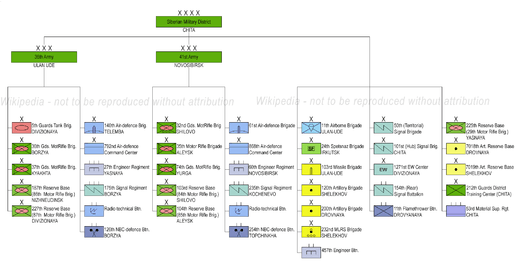Siberian Military District
The Siberian Military District was a Military district of the Russian Ground Forces. The district was originally formed as a military district of the Russian Empire in 1864. In 1924 it was reformed in the Red Army. After the end of World War II the district was split into the Western and Eastern Siberian Military Districts. In 1956 the district was reformed. In 2010 it was divided between the two newly formed Central and Eastern Military Districts.
| Siberian Military District | |
|---|---|
| Сибирский военный округ | |
 Siberian Military District Coat of Arms | |
| Founded | August 6, 1864 |
| Country | |
| Branch | Russian Ground Forces |
| Type | Military district |
| Part of | Ministry of Defence |
| Headquarters | Chita |
| Decorations | |
History
In 1998, seven years after the fall of the Soviet Union, the District as it is today was formed by the amalgamation of the previous Siberian and Transbaikal Military Districts, and on their merger gave up the vast Sakha Republic (or Yakutia) to the expanded Far Eastern Military District.
The Siberian Military District was originally formed in 1864, being one of the ten original military districts of the Russian Empire. It was recreated in June 1924 with the consolidation of the Western, Central and Eastern Siberian Military Districts, which had become the Imperial Military Districts in the area. In June 1941 the District was host to the 24th Army, under Lieutenant General Stepan Kalinin, which comprised two Rifle Corps, the 52nd and 53rd.[1] The 52nd, with its headquarters in Novosibirsk along with the 133rd Rifle Division, additionally had the 166th Rifle Division at Barabinsk and the 178th Rifle Division at Omsk. The 53rd Rifle Corps at Krasnoyarsk, where the 119th Rifle Division was stationed, also included the 107th Rifle Division at Barnaul and the 91st Rifle Division at Achinsk.
Among the many, many formations the district raised during the Second World War was the 75th Cavalry Division, formed in September and October 1941.
Immediately after the end of World War II, on July 9, 1945, to facilitate the demobilisation process, the Siberian Military District was divided into the Western and Eastern Siberian Military Districts. The Western Siberian Military District was headquartered at Novosibirsk, and created from HQ 8th Army, covered the Tyumen Oblast, the Omsk Oblast, Novosibirsk, the Tomsk Oblast, the Kemerovo Oblast and Altay. The Eastern Siberian District was located at Irkutsk and created from HQ 50th Army. The Eastern Siberian District was disbanded in 1953 with its region being split between the Western Siberian District and the Transbaikal Military District. On January 4, 1956 the Western Siberian Military District was again renamed the Siberian Military District.[2]
In 1968 the 33rd Army Corps was transferred into the district from the Turkestan Military District, establishing its headquarters at Kemerovo.[3] The 13th Motor Rifle Division at Biysk was assigned to it. Among the mobilisation divisions formed in the district from the late 1970s was the 167th Motor Rifle Division, whose equipment storage area was co-located with the barracks of the 13th MRD.
The 242nd Motor Rifle Division was established at Abakan in 1972.
In 1974 for their great contributions to the cause of strengthening the defence of the Soviet State and its armed protection, successes in combat and political training, the Transbaikal Military District was rewarded with the Order of Lenin, and the Siberian Military District with the Order of the Red Banner.
In August 1992, the 21st Motor Rifle Division, withdrawn from the 2nd Guards Tank Army in East Germany, was moved to Omsk.[4]
District forces c. 2009–2010

The 41st Army was formed from the headquarters of the former Siberian Military District at Novosibirsk while the new district’s headquarters were established at Chita (the former Transbaikal MD HQ). It is likely safe to assume that the 41st Army controls all the field formations of the previous Siberian Military District.
The IISS listed the district in 2006 as having a total of one tank, two motor-rifle and one machine-gun artillery divisions, two motor-rifle and one air assault brigades.[5] The 2nd Guards Tank Division, previously active in Mongolia with the 39th Army, disbanded in 2005 having been stationed at Strugi Mirnaya/Bezrechnaya (ru:Безречная), 50 43 25N, 116 10 35E) in Chita Oblast.[6] Also, while the 21st 'Tagenrog' Motor Rifle Division, withdrawn from Germany to the former Siberian Military District, was apparently partially re-equipped with the T-90 MBT in the mid-1990s, in 2000 it was apparently disbanded.[7]
The 29th Army at Ulan-Ude was seemingly disbanded in the course of 2007.[8]
- District troops
- 11th Air Assault Brigade (498th, 499th Battalions, 500th Btn recently disbanded)
- 24th Spetsnaz Brigade (Irkutsk; formerly at Kykhta / Ulan Ude)
- 120th Artillery Brigade (Chistye Klyuchi, Shelekhov) (8 BM-27 Uragan MRL, 18 152 mm howitzer 2A65)[9]
- 232nd Multiple Rocket Launcher Brigade (Chistye Klyuchi, Shelekhov)(18 BM-27 Uragan MRL)
- 7018th Base for Storage of Rocket and Artillery Equipment (Drovyanaya)
- 7019th Base for Storage of Rocket and Artillery Equipment (Chistye Klyuchi, Shelekhov) – former 12th Artillery Division
- 104th Base for Storage of Weapons and Equipment (VKhVT) (Aleysk) (85th MRB)
- other units
- 36th Army, Ulan Ude (formerly Borzya, moved February 2009)[10]
- 5th Separate Guards Tank Brigade (Divizionnaya, Ulan Ude region) (former 5th Guards Tank Division)
- 36th Guards Independent Motor Rifle Brigade (Borzya) (former 131st Motor Rifle Division, Sretensk)
- 37th Guards Independent Motor Rifle Brigade (Kyakhta) (former 6 VKhVT, and 245th Motor Rifle Division)
- 200th Artillery Brigade (Drovyanaya) (8 BM-27 Uragan MRL, 18 152 mm howitzer 2A65, 6 100 mm МТ-12 anti-tank guns, 9P149 "Shturm-С" – 18)
- 41st Army, Novosibirsk
- 32nd Independent Motor Rifle Brigade, (Novosibirsk) (former 85th Motor Rifle Division)
- 35th Guards Independent Motor Rifle Brigade (former 122nd MRD) (Aleysk) (The 5th Guards Tank Corps was originally part of the USSR 6th Guards Tank Army and was transferred as part of 6th Guards Tank Army to the Transbaikal Military District in preparation for the Soviet invasion of Manchuria in August 1945. The 5th Guards Tank Corps took part in this offensive and afterwards, soon after the Japanese surrender on 2 September 1945, was reorganised as the 5th Guards Tank Division. In 1957, the 5th Guards Tank Division (first formation) was reorganised as the 122nd Guards Motor Rifle Division.)[11]
- 74th Guards Motor Rifle Brigade, Yurga (Constant readiness)
- 103rd Base for Storage of Weapons and Equipment (Shilov, Novosibirsk Oblast) (84th MR Bde; formed from former 85th MRD)
Subordinate units

Order of Lenin Siberian Military District 2010:
- Combat formations:
- 36th Army, Ulan Ude
- 5th Guards Independent Tank Brigade "Don-Budapest", in Divizionaya equipped with T-90
- 36th Guards Independent Motor-Rifle Brigade "Lozovskaya", in Borzya equipped with BMP-3 and T-72[12]
- 37th Guards Independent Motor-Rifle Brigade "Tachinskaya", in Kyakhta equipped with BMP
- 187th Reserve Base (86th Independent Motor-Rifle Brigade) in Nizhneudinsk
- 227th Reserve Base (87th Independent Motor-Rifle Brigade) in Divizionaya
- 41st Army, Novosibirsk
- 32nd Independent Motor-Rifle Brigade "Leningrad-Pavlovskaya", in Shilovo equipped with BTR and T-90
- 35th Independent Motor-Rifle Brigade "Volgograd-Kiev", in Aleysk equipped with BMP-2 and T-72
- 74th Guards Independent Motor-Rifle Brigade "Zvenigorod-Berlin", in Yurga equipped with BMP-3 and T-72
- 103rd Reserve Base (84th Independent Motor-Rifle Brigade), in Shilovo
- 104th Reserve Base (85th Independent Motor-Rifle Brigade), in Aleysk
- 225th Reserve Base (29th Independent Motor-Rifle Brigade), in Yasnaya
- 11th Independent Airborne Brigade, in Sosnovyy Bor, Ulan-Ude – formed 1968[13]
- 24th Spetsnaz Brigade, in Irkutsk
- 212th Guards District Training Center, in Chita[14]
- 36th Army, Ulan Ude
- Missile and Artillery formations:
- 103rd Rocket Brigade in Ulan-Ude (SSM)
- 232nd MLRS Brigade in Shelekhov
- 120th Artillery Brigade in Shelekhov
- 200th Artillery Brigade in Drovnaya
- 7018th Artillery Reserve Base in Drovnaya
- 7019th Artillery Reserve Base in Shelekhov
- Air-defence formations:
- 36th Army
- 140th Air-defence Missile Brigade in Telemba
- 792nd Air-defence Command Center
- 41st Army
- 61st Air-defence Missile Brigade
- 868th Air-defence Command Center
- 36th Army
- Engineering formations:
- 27th Engineer Regiment in Yasnaya (36th Army)
- 60th Engineer Regiment in Novosibirsk (41st Army)
- 457th Independent Engineer Battalion
- NBC-defence formations:
- 11th Independent Flamethrower Battalion in Drovyanaya
- 126th Independent NBC-defence Battalion in Borzya (36th Army)
- 254th Independent NBC-defence Battalion in Topchinkha (41st Army)
- Signal formations:
- 50th (Territorial) Signal Brigade
- 101st (Communications Hub) Signal Brigade "Khinganskaya" in Chita
- 1271st Electronic Warfare Center in Divizionaya
- 175th Independent Signal Regiment in Borzya (36th Army)
- 235th Independent Signal Regiment in Kochenevo (41st Army)
- 154th Independent (Rear) Signal Battalion
- Logistic formations:
- 53rd Material Support Regiment in Chita
Commanders
- Yan Gaylit: 1923-1924
- Robert Eideman
- Nikolay Kuibyshev
- Mikhail Lewandowski: 1930-1933
- Yan Gaylit: 1933-1937
- Pavel Dybenko
Western Siberian MD
- General Lieutenant V.I. Kurdyumov (Formation? – Oct 1946),
- General of the Army Andrei Yeremenko (Oct 1946 – Nov 1953)
Siberian MD
- General Colonel N.P. Pukhov (1953 – Jul 1957)(former commander of 13th Army)
- General Colonel Pyotr Koshevoy (Jul 1957 – Apr 1960),
- General Colonel G V Baklonov (May 1960 – 1964),
- General Colonel S.I. Ivanov (1964–1968),
- General Colonel V.F. Tolubko(1968 – May 1969)
- General Colonel Mikhail Homulo (May 1969 – Dec 1978)
- General Colonel Boris Snetkov (Jan 1979 – Nov 1981)
- General Colonel Nikolai Popov (Nov 1981 – Sep 1984)
- General Colonel Vladimir Vostrov (Sep 1984-7)
- General Colonel Nikolai Vasilyevich Kalinin (7-07 1987)
- General Colonel Boris Pyankov (Apr 1988 – Aug 1991)
- General Lieutenant V.A. Koplov (с Sep 1991 – 1997)
- Nikolai Kormiltsev (Dec 1998 – Mar 2001)
- General Vladimir Boldyrev (May 2001 – Dec 2002)
- Nikolai Makarov (Dec 2002–)
- Alexander Postnikov ( – 2009)
- General Lieutenant Vladimir Chirkin (2009–2010)[15]
Notes
- See Leo Niehorster, http://niehorster.org/012_ussr/41_oob/stavka-reserves/army_24.html and http://niehorster.org/012_ussr/41_oob/interior/_siberia.html
- http://www.ww2.dk/new/army/gkv/sibvo.htm
- Holm, Michael. "33rd Army Corps". www.ww2.dk. Retrieved 2016-05-18.
- Feskov et al. 2013, 396; Holm, 21st Taganrogskaya Motorised Rifle Division
- Routledge for the IISS, The Military Balance 2006, p. 160
- Michael Holm, 2nd Guards Tank Division, 2015.
- Taganrogskaya Red Banner order of Suvorov. See also http://www.ww2.dk/new/army/msd/21msd.htm.
- Vad777's Siberian Military District page (Russian language), late July 2007, see Army article for link
- "Archived copy". Archived from the original on 2008-05-13. Retrieved 2010-03-18.CS1 maint: archived copy as title (link), accessed March 2010
- http://www.zabmedia.ru/?page=news&rubr=8&text=13721, accessed March 2010
- "5th Guards Tank Division". www.ww2.dk. Retrieved 2017-06-24.
- http://yasnay.ru/index/0-4
- Holm
- See http://www.ww2.dk/new/army/td/49td.htm and "Archived copy". Archived from the original on 2009-09-10. Retrieved 2010-04-18.CS1 maint: archived copy as title (link)
- RIA Novosti, Russia appoints new Ground Forces chief, other top commanders, 13 January 2010
References
- Greg Austin and Alexey Muraviev, The Armed Forces of Russia in Asia, Tauris, 2000
- Feskov, V.I.; Golikov, V.I.; Kalashnikov, K.A.; Slugin, S.A. (2013). Вооруженные силы СССР после Второй Мировой войны: от Красной Армии к Советской [The Armed Forces of the USSR after World War II: From the Red Army to the Soviet: Part 1 Land Forces] (in Russian). Tomsk: Scientific and Technical Literature Publishing. ISBN 9785895035306.
Further reading
- V Plameni I Slave: Ocherki Istorii Sibirskogo Voyennogo Okruga. [In Fire and Glory: An Outline History of the Siberian Military District], (Novosibirsk: Zapadno-Sibirskoye Knizhizdat, 1969.